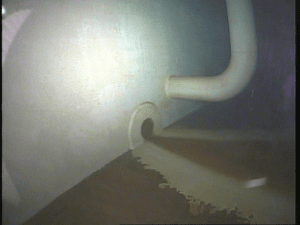IN-HOUSE VERSUS THIRD PARTY STORAGE TANK INSPECTIONS
Storage tanks, just like any asset, require attention and maintenance. Storage tanks – whether they hold water, gasoline or a chemical – should be frequently evaluated. Tank operators can help keep their tanks in working order by performing regular in-house inspections. Professional tank inspectors should be contracted to perform more thorough inspections as regulations and codes or at the discretion of the tank owner or operator.
Fire protection tanks supply the water that comes out of hydrants and sprinkler systems. Periodic tank inspections should be conducted on fire protection tanks. NFPA 25 recommends that fire protection tanks without cathodic protection be inspected and cleaned out every three years. Tanks with cathodic inspection don’t need to be inspected as often – just every five years.
A lot can happen in a three- or five-year gap. Operators should evaluate the tank regularly to make sure the tank is in working order and there are no pressing issues that would require maintenance or repair.
An operator should make sure the tank is secure at all times. Fire protection tanks should, ideally, be enclosed by fencing with a locked gate to keep intruders out. No trespassing signs should also be posted and visible on the fence.
Operators should always look for exterior corrosion. Welded steel tanks that are outdoors, and even if they are indoors, are susceptible to the elements. Repeated exposure to water and air can cause steel to corrode over time. Rusting can lead to the tank’s deterioration and possible failure. Even if the corrosion is not widespread, it can still structurally weaken the steel. If there’s extreme rusting or if there’s an area with a lot of pitting – it would be wise to seek a third party’s opinion.
If a leak is discovered, an engineer knowledgeable about water tanks should be contacted immediately to evaluate the water tank. Leaks mean water loss and, in the most extreme cases, could lead to a tank failing.
Tornadoes, hurricanes, straight-line winds, earthquakes, and other such weather disasters can damage structures, even something as durable as a storage tank. Operators should examine their storage tanks following storms and natural disasters, paying special attention to any damage or leaks. If any damage is found, and even if it isn’t, after a natural disaster to ensure everything is in working order.
Winter tank inspection
It’s just as important, if not more important, for operators to be familiar with their storage tank’s interior. Water inside a storage tank has been known to freeze if it gets too cold. Mixing systems can be installed to keep the water moving so it’s not stagnant enough to freeze. During the cold winter months, operators should check and make sure their tank’s mixing system is in working order.
Fire protection tanks should be washed out regularly to get rid of sediment that settles at the bottom. This mixture of dirt, grit, and sand can cause blockages if it’s sucked up into a sprinkler system, possibly preventing the sprinkler system from working when there’s a fire. A professional maintenance company should be contracted to perform this work.
Professional tank inspectors are well versed in codes and regulations. They will methodically examine each part of a storage tank, both on the exterior and the interior. They will work from a checklist of items that address each relevant code and regulation as they inspect a tank.
An inspector will look at everything from the foundation to ladders to the tank shell, the roof, vents, manways and weld seams, among other things. The tanks will be inspected to make sure they are in compliance with all state and federal codes – including but not limited to OSHA, EPA, AWWA, NFPA 22 and NFPA 25. For example, an inspector will examine anchor bolts and note if there is any deterioration and if they are the proper size and length. Anchor bolts must be strong enough to withstand 100 mph winds in any direction as required by AWWA D103-05.
Dry inspections, remotely operated underwater vehicles (ROVs) inspections, and diver inspections are three ways to inspect a fire protection tank. As the name implies, a dry inspection means the tank has been emptied of water and is dry. This means the tank must be taken out of service temporarily until work is completed. It’s not necessary to drain a tank for ROV or diver inspections. Naturally, since a fire protection tank feeds water to sprinkler systems and hydrants when there’s a fire, most tank owners don’t want their tank out of service for any amount of time so ROV and diver inspections are appealing alternatives to dry inspections.
Once the inspectors are done with their inspections, they will prepare a thorough report with pictures of everything that was evaluated. The report will have a breakdown of each item they reviewed. The report will also include a listing of any deficiencies found and recommendations for repairs or upgrades with references to specific codes and regulations that require attention.
There’s some overlap in how tank operators evaluate an API-style tank and a fire protection tank. As with the latter, tank owners should look for signs of corrosion, make sure the foundation is not cracking and is free of brush and vegetation, and make sure it is properly ventilated or sealed.
Inspectors looking at API-style tanks will give a service life evaluation – noting how many more years the tank shell is estimated to remain serviceable. Ultrasonic testing is done to measure the general thickness of bottom shell plates.
If the tank stores a flammable substance, the tank owner or operator must remove the product before and certify that the inspection is safe to enter before the inspector arrives. It should also be isolated from any electrical power, steam lines or product lines.
Inspectors will look for any source of potential contamination. In a fire protection tank, this means looking closely at the vent screening and the overflow pipe. With API-style tanks, this means reviewing internal floating roofs.
During a professional tank inspection, tanks with internal floating roofs should be tested for explosive gas. If any explosive gas is measured, this could mean the roof is leaking or there’s a leak in the seal system, either of which should be remedied immediately.
When looking at a tank’s foundation, the inspector will check for breaks or cracks in the concrete. Is there any vegetation, trash, or debris around the foundation? If so, it should be removed through in-house maintenance or by a professional landscaper. Tanks containing flammable products don’t need items near it that could fuel flames.
As for the shell of the tank, an inspector will look for paint failure, corrosion, and pitting. Inspectors should also look for cracks or any signs of leaking on weld joints at manways, reinforcing plates and nozzles. Depending on the product stored, some API storage tanks require secondary containment. Part of an inspector’s checklist is to make sure the secondary containment is up to code and functioning.
Copyright © 2024 Pittsburg Tank & Tower Group. All Rights Reserved






















